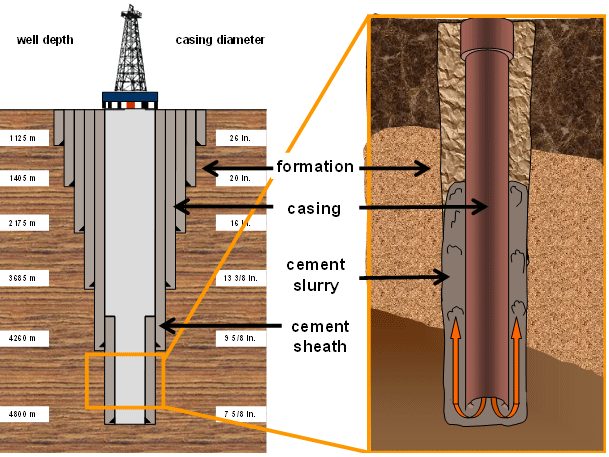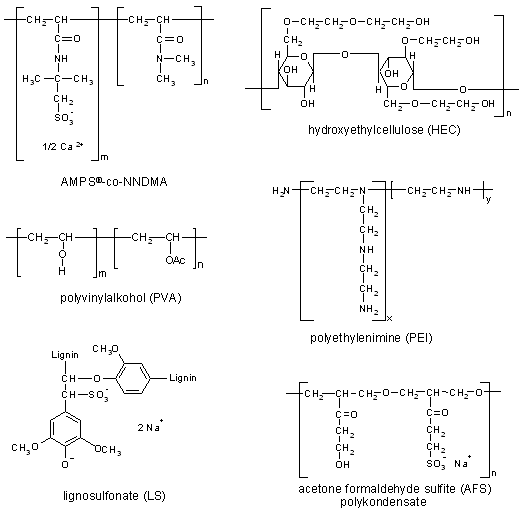Oil Well Cementing
Well cementing is one of the most important operations performed on an oil or gas well. The primary task of a cement job is to keep the casing in place, to prevent corrosion e.g. from saline formation water, and, most important, to avoid the influx of fluids or gases into the annular space and to prevent them from migrating to upper or lower zones ("zonal isolation"; see Fig. 1). Proper zonal isolation is the key to the safe production of hydrocarbons. In 2007, 108,000 wells with a total cementing strata of 160,000 km will be cemented worldwide [1]. More than 1 mio. tons of oil well cement will be used on oil and gas fields.

Fig. 1: Schematic of a cased and cemented oil well (left); principle of placing the cement slurry between the casing and the formation (right).
Depending on the well conditions such as e.g. depth, temperature, pressure, salinity etc., various chemical admixtures, including fluid loss additives, dispersants, retarders, anti-gas migration polymers etc. are used to achieve the complex properties required from the cement slurry (see Fig. 2). Because of very diverse well conditions, an universal cement additive delivering all the functions required is difficult to achieve. Instead, combinations of several admixtures are carefully engineered to provide optimum results with respect to its technical performance.
High temperature stable fluid loss additives (FLAs), e.g. CaAMPS® copolymers, are added to the cement to prevent water loss from the slurry while it is pumped along a porous formation. Dispersants, e.g. acetone formaldehyde sulfite polycondensates, reduce the viscosity of the cement slurry during the mixing procedure and facilitate the pumpability over a distance of several kilometers. Lignosulfonates are used to retard cement hydration to allow for sufficient pumping time which is required to successfully place the slurry between casing and formation.
For optimum results from the admixtures, it is helpful to profoundly understand their working mechanisms. Colloidal chemistry investigation methods, e.g. adsorption and zeta potential measurements, are used to study the surface processes which determine the efficiency of the products. Based upon these fundamentals, the effectiveness of the additives can be optimized. Our chair investigates and publishes on the working mechanism of oil well cement additives.
High temperature stable fluid loss additives (FLAs), e.g. CaAMPS® copolymers, are added to the cement to prevent water loss from the slurry while it is pumped along a porous formation. Dispersants, e.g. acetone formaldehyde sulfite polycondensates, reduce the viscosity of the cement slurry during the mixing procedure and facilitate the pumpability over a distance of several kilometers. Lignosulfonates are used to retard cement hydration to allow for sufficient pumping time which is required to successfully place the slurry between casing and formation.
For optimum results from the admixtures, it is helpful to profoundly understand their working mechanisms. Colloidal chemistry investigation methods, e.g. adsorption and zeta potential measurements, are used to study the surface processes which determine the efficiency of the products. Based upon these fundamentals, the effectiveness of the additives can be optimized. Our chair investigates and publishes on the working mechanism of oil well cement additives.

Fig. 2: Chemical structure of some polymers commonly used in oil well cementing.
Another field of research is the study of oil well cement chemistry. Due to the elevated temperature and pressure, oil well cement forms quite different hydration phases, compared to conventional EN or ASTM construction cements. Our chair focuses on investigations of cement hydration in presence of microsilica, fly ash, slag and other secondary cementitious materials.
[1] World Oil, Special Focus: Outlook 2007 Worldwide Drilling, in World Oil
Magazine, Houston, TX 2007, Vol. 228 (2).

